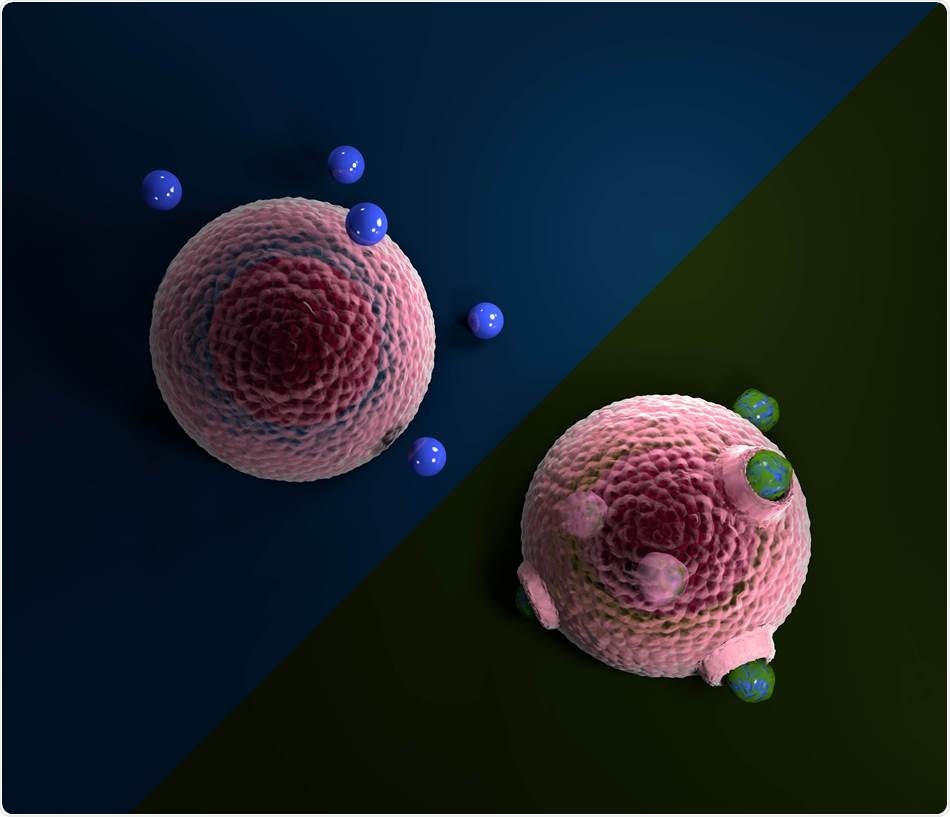Microplastics have polluted the global environment. These minute particles enter food chains and eventually end up in the digestive systems of humans and animals.

Microplastic that was exposed to the environment builds up an ecocorona (right) and is much more likely internalized by cells than pure unmodified microplastic (left). Image Credit: University of Bayreuth.
Such particles can also be inhaled. Moreover, small microplastics are not excreted but instead, they can become integrated into the body tissue.
Now, scientists from the University of Bayreuth have found that microplastic particles can easily enter the living cells if they were subjected to natural aquatic surroundings, that is, seawater and freshwater.
Biomolecules that occur in the water accumulate on the surfaces of microplastics, which support the internalization of these particles into cells. The team has reported the results of their study in the Science Advances journal.
Headed by Professor Dr. Christian Laforsch (Animal Ecology) and Professor Dr. Holger Kress (Biological Physics), the interdisciplinary research group targeted the microplastic particles, measuring around 3 µm in diameter, for their study. Such tiny particles are usually present in the environment.
To replicate their exposure in aquatic environments, the researchers placed some microplastic particles in freshwater collected from an artificial pond, and then placed other microplastic particles in saltwater collected from a marine aquarium. In less than two weeks of exposure time, biomolecules were deposited on the particle surfaces.
Spectroscopic examinations indicate that these biomolecules are carbohydrates, amino acids, nucleic acids, and proteins. We are talking about an ‘eco-corona’ that forms on the microplastic particles in a natural environment.”
Anja Ramsperger, MSc, Study First Author and PhD Student, Department of Animal Ecology I, University of Bayreuth
Ramsperger is part of the Biological Physics group.
The researchers subsequently analyzed the microplastic particles covered with biomolecules to find out their mode of interaction with living cells. And for this purpose, they used cells from a recognized mouse cell line.
To differentiate whether the particles are truly internalized or simply bind to the cell exterior, the researchers stained the crucial constituents of the cell interior, called the actin filaments. The resulting microscopic images revealed the internalized particles in the form of “dark holes.”
The fluorescent labeling of the actin filaments enabled us to see exactly which particles were internalized by the cells. Based on spectroscopic methods, we verified that these particles were indeed microplastics—or more precisely: polystyrene particles—and not accidental impurities.”
Dr Holger Kress, Professor of Biological Physics, University of Bayreuth
In this experiment, the control group contained tiny plastic particles that had been incubated in ultra-pure water, and hence were not covered with an eco-corona. The team observed that such untreated tiny plastic particles were only intermittently internalized by the cells.
Our study supports the assumption that microplastics which were exposed to the natural environment—and are therefore coated with biomolecules—not only pass through the digestive tract when ingested with food, but may also be incorporated into tissue. The coating of biomolecules may act as a kind of Trojan horse that allows plastics to be internalized into living cells.”
Dr Christian Laforsch, Chair of Animal Ecology I, University of Bayreuth
Dr. Laforsch is also the spokesperson of the DFG-funded “Microplastics” Collaborative Research Centre at the University of Bayreuth.
Dr. Laforsch continued, “The precise damage that the particles can cause here has not yet been sufficiently investigated. It is also still largely unclear which of the properties of microplastics are actually responsible for any negative effects. These questions represent a central topic for the 'Microplastics’ Collaborative Research Centre in Bayreuth.”
“Finding precise answers to these questions is important in order to be able to develop new materials and solutions in this area in the future,” Dr Laforsch added.
“The interdisciplinary network in the 'Microplastics’ Collaborative Research Centre enables us to examine the complex questions that this topic poses with the necessary diversity of research approaches and perspectives. The need for an interdisciplinary approach is evident in the study now published. Scientists from various scientific disciplines at the University of Bayreuth have contributed to it—from animal ecology, to polymer chemistry, to biological physics, concluded Dr Laforsch.
Source:
Journal reference:
Ramsperger, A. F. R. M., et al. (2020) Environmental exposure enhances the internalization of microplastic particles into cells. Science Advances. doi.org/10.1126/sciadv.abd1211.